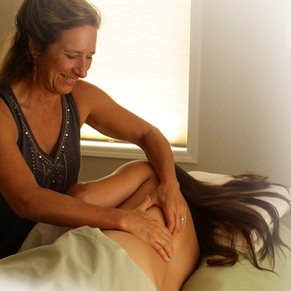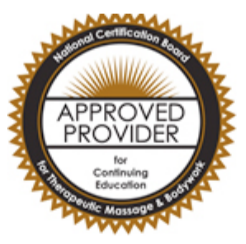FUNDAMENTALS OF PRENATAL MASSAGE (ONLINE)
Course Overview
INSTRUCTOR/AUTHOR: Leslie Stager RN, LMT, NCBTMB Provider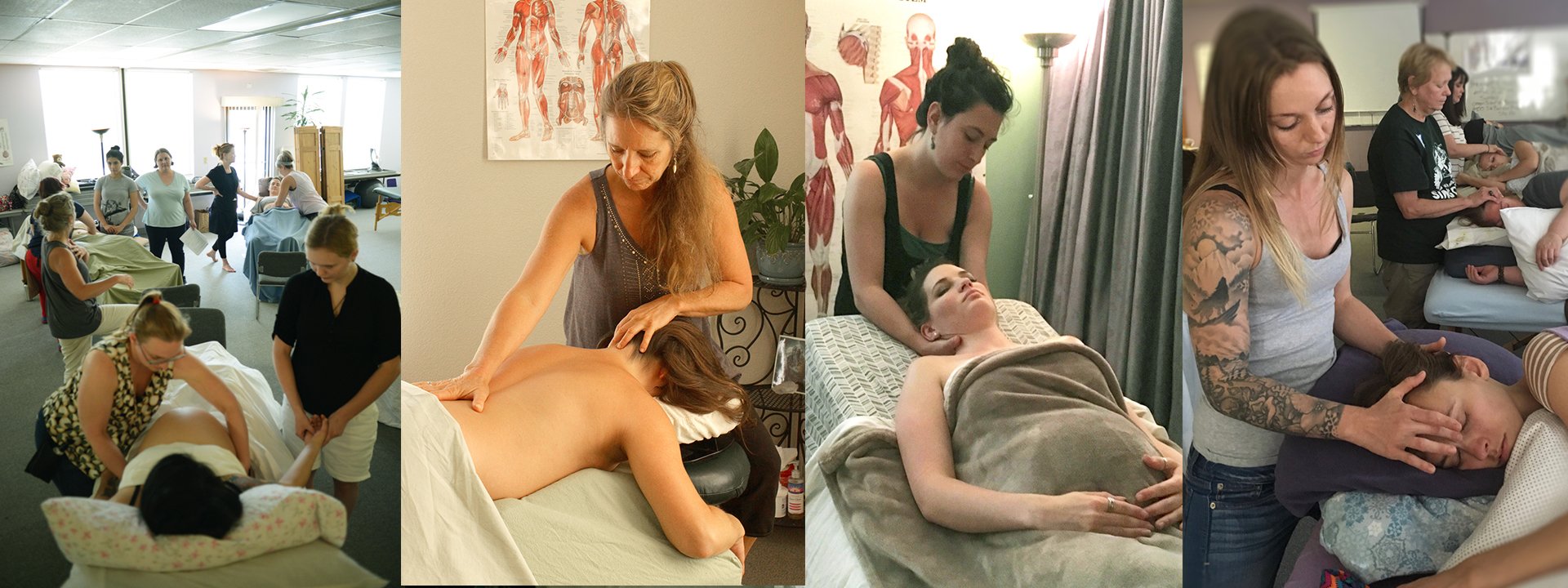
Read Course Overview, Instructions, and LEARNING OBJECTIVES below before starting the Lessons!
MotherTouch Fundamentals of Prenatal Massage Online covers all the basics so you can work conscientiously and carefully with your prenatal clients. In 6 modules, you’ll learn Benefits, Touch Traditions, Pregnancy A&P and Pathology, Contraindications, Draping, Positioning, and Massage techniques for Sidelying, Semi-reclining, and the pregnant belly!
If you want to specialize with this clientele, take Leslie’s Live course:MotherTouch Prenatal Bodywork Training. You’ll get focused instructor supervision, guidance, and support, practice optimal body mechanics, and get questions answered immediately with far more depth than you can get in an online course!
Read the LEARNING OBJECTIVES, and other sections below before starting the Lessons!
COURSE TOPICS — Click to Open & Read Expand
MotherTouch Fundamentals of Prenatal Massage Online is divided into 6 Modules that cover the information essential to your safe practice with pregnant clients.
- Module I: Prenatal Massage Benefits & Traditions
- Content: Touch Traditions; Benefits of Pregnancy Massage; Issues about Touch during Pregnancy; Dispelling some myths; Conception through Birth; Honoring the Wisdom Keepers.
- Module II: Physiological & Muscular Changes During Pregnancy
- Content:: Physical changes through the trimesters;Hormonal affects and how they impact your bodywork; Postural Support techniques; Uterine ligaments–preventing strain; Impact of Diastasis Recti; Treatments for Psoas and Quadratus Lumborum
- Module III: Precautions & Contraindications
- Content: Bodywork Styles; Health Intake & Medical Release; Bodywork Precautions; Pregnancy Risk Conditions and High Risk Symptoms
- Module IV: Positioning & Draping for Pregnancy Massage
- Content:Office Considerations; Sidelying Positioning Benefits and How To; Avoiding Uterine Ligament and Hip Rotator Strain; Semi-Reclining Positioning Benefits: When and How To Use; Draping the Back; Draping the Leg
- Module V: Basic Massage Techniques During Pregnancy
- Content: Office Considerations; Trimester Considerations; Massage for the Hands, Arms, Shoulder, Neck, Lateral Hip Rotators, Gluteals
- Content: The Sacred Belly; Trimester Considerations; Belly Massage Techniques in Sidelying Position; Belly Massage Techniques in Semi-Reclining Position; Addressing Uterine Round Ligament PainModule VI: Abdominal Massage During Pregnancy
- OPTIONAL MENTORING with LESLIE
- To have the opportunity to audit the first day of the LIVE Fundamentals class in MotherTouch 32-hour Prenatal Bodywork Training & Certification , you must participate in a private mentoring session with Leslie to demonstrate positioning and draping skills, and applying some basic techniques that you learned in the online course. Go back to the Main page of the Online classes, and register there for private mentoring!
START COURSE HERE: INSTRUCTIONS & NCBTMB CE CREDIT–Click to open & read Expand
For information about using NCBTMB continuing education credit in your state, please consult your professional licensing board. The number of CE’s per course is based partly on
NCBTMB reading time measurement of 250 words per minute and partly on actual read time by sample participants.
Follow these steps to earn NCBTMB credits and receive certificate of completion:
- READ the learning objectives below.
- STUDY all written content online or printed out.
- WATCH all videos and powerpoint videos.
- LESSONS: Do each Lesson in sequential order–they often build information on one another. When done with a Lesson, click on the button “Mark Complete” at the bottom of the page .
- QUIZ: Choose the best answer based on the LESSON material. Refer to the source listed within the question if you need to review. Do Not use random information gathered from internet!
- PROGRESS BAR: The bar above the lessons will fill in with color as you continue through the course.
- Complete the Evaluation Form to provide honest feedback for future programming.
- CERTIFICATE: Upon successful completion of steps 1-5, you may view or print your certificate. You may not alter the certificate. If you find any error, contact MotherTouchClasses@gmail.com to request a correction.
- CE’s: You are responsible to keep track of your CE’s. MotherTouch™ is not responsible for lost or unrecorded CE’s once you have downloaded the certificate.
- SAVING YOUR WORK: You may stop at any time during the course or Quiz and come back to it later. Your answers will be saved.
More About the QUIZ: To receive the MotherTouch™ Certificate of Completion participants must complete all activities listed, utilize materials offered, and answer multiple choice questions. Since you can refer to the text, video or other materials in this course while taking the quiz, you must receive a passing score of 80% in order to pass and receive your certificate
LEARNING OBJECTIVES — Click to open & read Expand
LEARNING OBJECTIVES
At the end of this course, the student should be able to:
MODULE I: Prenatal Massage Benefits
- List 3 unique aspects of working with pregnant, laboring and postpartum women.
- Discuss global use of touch traditions during pregnancy and birth.
- List and explain 11 benefits of touch during the childbearing cycle.
- Describe 2 ways touch during pregnancy affects a woman’s relationship to mothering her baby.
- Explain 2 myths and relevant facts about touch during pregnancy.
MODULE II: Physiological and Musculo-Skeletal Changes
- Discuss impacts of pregnancy weight gain on posture and its influences on bodywork sessions.
- List 7 factors contributing to postural change during pregnancy.
- Practice one method of enhancing client postural awareness.
- Name 4 uterine ligaments, location, and their pain referral pathways
- Describe one way to prevent uterine ligament strain as clients get on or off massage table.
- Define diastasis recti during pregnancy
- List at least 3 factors contributing to diastasis recti development during pregnancy.
- Describe one action a massage therapist can take to help clients minimize development of diastasis recti.
- Explain a simple outline of embryonic and fetal development through pregnancy.
- Describe bodywork contraindications and concerns during the 3 trimesters of pregnancy.
- Name 4 primary influential hormones of pregnancy and their effects on a mother’s body.
- List 4 physical effects that can develop due to effects of estrogen, progesterone, or relaxin and potential impacts to bodywork.
- List at least 2 common physical changes during 1st, 2nd, or 3rd trimester.
- Describe optimal positioning during each trimester.
- Explain when miscarriage is of greatest concern during pregnancy and why.
MODULE III: Precautions & Contraindications
- Create a health intake and medical release form that address specific bodywork concerns related to pregnant clients.
- Describe common bodywork-technique precautions and determine in which situations they would apply.
- Explain Leslie’s descriptions of sedating and potentially stimulating type bodywork (Type I and Type II) and the precautions or contraindications associated with each.
- List at least 3 high-risk obstetric conditions and their relevant bodywork precautions.
- Describe common symptoms of DVT or PE.
- Identify specific points most often contraindicated for use with acupressure during pregnancy.
- Ask appropriate questions to help discern what is a concerning condition of pregnancy or what is more likely just musculoskeletal discomfort.
- Explain the importance of a thorough health intake at an initial visit and update at each subsequent visit.
- Describe three potential consequences of improper client positioning during pregnancy massage.
- List 3 primary symptoms of preeclampsia that a bodyworker could plausibly encounter.
- Practice doing a health intake with a pregnant client.
- List 3 common pregnancy massage contraindications and explain why they are myths, not fact.
- Describe the causes and symptoms of diastasis recti and diastasis pubis
- Explain why there is greater risk for DVT during pregnancy
- List 5 conditions that increase the risk for an individual developing a DVT
- Discuss when the use of a medical release prior to massage is indicated and when to refer a client to her prenatal care provider based on symptoms that might indicate pregnancy-related problems.
- List 4 primary bodyworker precautions for pregnant clients
- Explain when and why supine positioning would be inappropriate
- Describe common symptoms of miscarriage
- Discuss bodyworker concerns associated with clients with surrogate pregnancy, twins, DVT, history of miscarriage.
MODULE IV: Positioning & Draping
- Practice positioning in sidelying and semi-reclining positions.
- List 8 concerns about prone positioning
- List 2 situations or conditions for when each positioning option might be optimal.
- List steps for setting up the table in preparation for sidelying pregnancy massage.
- Practice draping/undraping the legs, back, and belly in sidelying positioning.
- Explain why a larger flat sheet may be necessary for sidelying position.
- List 4 comfort issues that may arise with sidelying positioning.
- Discuss positioning concerns and choices for each trimester.
MODULE V: Massage Techniques
- List 8 office adjustments to accommodate pregnant clients
- Discuss the appropriateness of massage during the first trimester
- Practice two breath-relaxation techniques
- Describe 3 causes of sciatic-like pain during pregnancy
- Discuss benefits or detriments of different positions for each trimester
- Share with client partners or friends the sacral-compression and unwinding techniques.
- Describe and practice 20 different bodywork techniques useful for pregnant clients.
- Describe a benefit of doing anterior-posterior touch simultaneously
- Practice two ways of accessing the trapezius and levator scapula when client is in sidelying position.
- Practice 2 ways of relieving sacral discomfort in sidelying positioning.
MODULE VI: Abdominal Massage During Pregnancy
- Describe the MotherTouch approach to beginning massage for the pregnant belly
- List 3 contraindications or precautions for belly massage
- Describe how at least 2 other traditional birth cultures use belly massage
- 4. Practice specific massage techniques demonstrated in the videos
- 5. Discuss stretch mark products and their usefulness to prevent or reduce them
Course Menu
Module Vl: ABDOMINAL MASSAGE DURING PREGNANCY
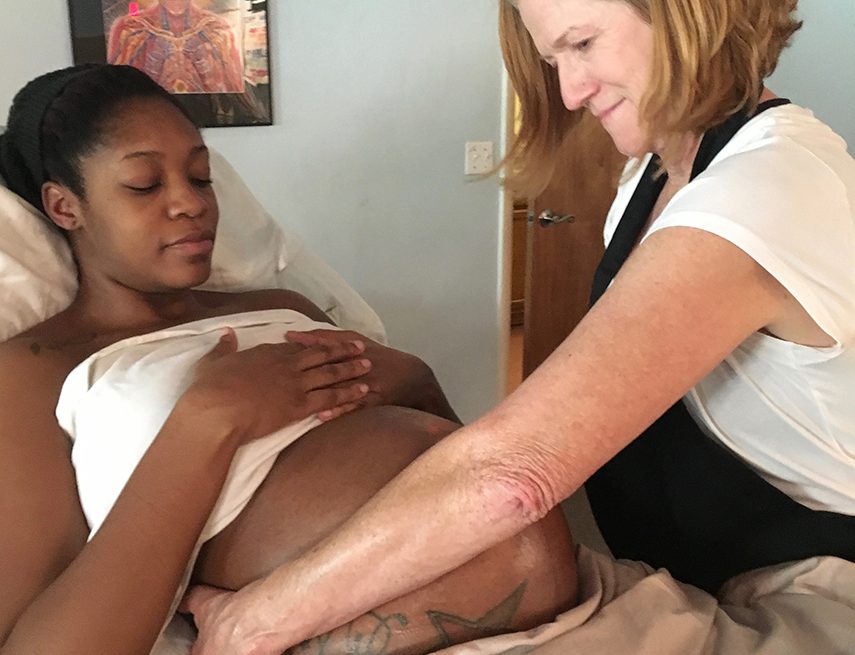
INSTRUCTOR: Leslie Stager RN, LMT
Learn various approaches to belly massage during pregnancy. Along with precautions and considerations, you’ll see specific techniques done in sidelying and semi-reclining positions that help relieve groin pressure, round ligament pain, and help mom and baby connection. You’ll read and see a video clip of traditional belly massage practices. Belly massage may be used to help prepare the body for labor, or can be sedating and help a woman reconnect when she has a history of miscarriage or preterm labor.
Topics include:
- The Sacred Belly
- Trimester Considerations
- Belly Massage Techniques in Sidelying Position
- Belly Massage Techniques in Semi-Reclining Position
- Stretch Marks
Content: Video, Reading
Course Menu
START COURSE HERE: INSTRUCTIONS & NCBTMB CE CREDIT–Click to open & read
Follow these steps to earn NCBTMB credits and receive your Certificate of Completion. For information about acceptance of NCBTMB CE’s in your state, please consult your professional licensing board. The number of CE’s per course is based partly on NCBTMB reading time of 250 words per minute, and partly on actual read time by sample participants.
- READ the learning objectives below.
- STUDY all Text content and WATCH all videos and powerpoint videos.
- LESSONS: Do each Lesson in sequential order–they may build information on one another.
- As you work with a Lesson, the arrow next to the lesson number in the Course Menu will turn Green to help you remember what you have done so far!
- QUIZ: Choose the best answer based on the LESSON material. Refer to the source listed within the question if you need to review. Do Not use random information gathered from internet!
- PROGRESS BAR: The bar above the lessons will fill in with color as you continue through the course.
- Complete the EVALUATION FORM to provide honest feedback for future programming.
- CERTIFICATE: Upon successful completion of steps 1-5, you may view or print your certificate. You may not alter the certificate. If you find any error, contact MotherTouchClasses@gmail.com to request a correction.
- CE’s: You are responsible to keep track of your CE’s. MotherTouch™ is not responsible for lost or unrecorded CE’s once you have downloaded the certificate.
- SAVING YOUR WORK: You may stop at any time during the course or Quiz and come back to it later. Your answers will be saved.
More About the QUIZ: To receive the MotherTouch™ Certificate of Completion participants must complete all activities listed, utilize materials offered, and answer multiple choice questions. Since you can refer to the text, video or other materials in this course while taking the quiz, you must receive a passing score of 80% in order to pass and receive your certificate.
LEARNING OBJECTIVES — Click to open & read
- By the end of this course, the student will be able to:
- Describe the MotherTouch approach to beginning massage for the pregnant belly
- List 3 contraindications or precautions for belly massage
- Describe how at least 2 other traditional birth cultures use belly massage
- Practice at least 4 specific belly massage techniques demonstrated in videos or text
- Discuss stretch mark products and their usefulness to prevent or reduce them
- List 6 benefits of Prenatal Belly Massage
- List 6 precautions to be aware of before doing abdominal massage during pregnancy
- Explain rationale for using either sidelying or semi-reclining positioning for a belly massage
`
Module V: PRENATAL MASSAGE TECHNIQUES
Course Overview
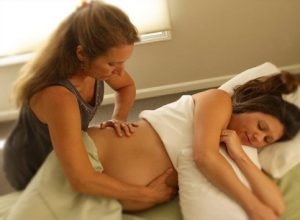 Certain themes are common to nearly every massage during pregnancy. For instance, a woman often has increased need for nurturing. She will benefit from stretching and muscular work that elongates areas shortened and compressing as pregnancy progresses. She will also benefit from attention to postural adaptations to her changing weight as discussed in the online course Physiological & Musculo-Skeletal Changes During Pregnancy (Module II).
Certain themes are common to nearly every massage during pregnancy. For instance, a woman often has increased need for nurturing. She will benefit from stretching and muscular work that elongates areas shortened and compressing as pregnancy progresses. She will also benefit from attention to postural adaptations to her changing weight as discussed in the online course Physiological & Musculo-Skeletal Changes During Pregnancy (Module II).
This course demonstrates specific bodywork techniques for sidelying and semi-reclining position that support women throughout their pregnancy and which you can practice easily after watching here.
TOPICS INCLUDE:
- Office Considerations
- Trimester Considerations
- Massage for the Hands, Arms, Shoulder, Neck, Lateral Hip Rotators, Gluteals
- Massage Techniques for Sidelying Position
- Massage Techniques for Semi-Reclining Position
Content: Video, Text
Course Menu
START COURSE HERE: INSTRUCTIONS & NCBTMB CE CREDIT–Click to open & read
Follow these steps to earn NCBTMB credits and receive your Certificate of Completion. For information about acceptance of NCBTMB CE’s in your state, please consult your professional licensing board. The number of CE’s per course is based partly on NCBTMB reading time of 250 words per minute, and partly on actual read time by sample participants.
- READ the learning objectives below.
- STUDY all Text content and WATCH all videos and powerpoint videos.
- LESSONS: Do each Lesson in sequential order–they may build information on one another.
- As you work with a Lesson, the arrow next to the lesson number in the Course Menu will turn Green to help you remember what you have done so far!
- UIZ: Choose the best answer based on the LESSON material. Refer to the source listed within the question if you need to review. Do Not use random information gathered from internet!
- PROGRESS BAR: The bar above the lessons will fill in with color as you continue through the course.
- Complete the EVALUATION FORM to provide honest feedback for future programming.
- CERTIFICATE: Upon successful completion of steps 1-5, you may view or print your certificate. You may not alter the certificate. If you find any error, contact MotherTouchClasses@gmail.com to request a correction.
- CE’s: You are responsible to keep track of your CE’s. MotherTouch™ is not responsible for lost or unrecorded CE’s once you have downloaded the certificate.
- SAVING YOUR WORK: You may stop at any time during the course or Quiz and come back to it later. Your answers will be saved.
More About the QUIZ: To receive the MotherTouch™ Certificate of Completion participants must complete all activities listed, utilize materials offered, and answer multiple choice questions. Since you can refer to the text, video or other materials in this course while taking the quiz, you must receive a passing score of 80% in order to pass and receive your certificate.
LEARNING OBJECTIVES — Click to open & read
- List 8 office adjustments to accommodate pregnant clients
- Discuss the appropriateness of massage during the first trimester
- Practice two breath-relaxation techniques
- Describe 3 causes of sciatic-like pain during pregnancy
- Discuss benefits or detriments of different positions for each trimester
- Share with client partners or friends the sacral-compression and unwinding techniques.
- Describe and practice 20 different bodywork techniques useful for pregnant clients.
- Describe a benefit of doing anterior-posterior touch simultaneously
- Practice two ways of accessing the trapezius and levator scapula when client is in sidelying position.
- Practice 2 ways of relieving sacral discomfort in sidelying positioning.
Module IV: POSITIONING & DRAPING FOR PREGNANCY MASSAGE
Course Overview
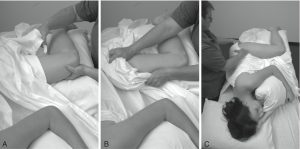
Pregnancy bodywork demands creativity and requires alternative positionings. One setup does not fit all clients! Sidelying or semi-reclining positioning skills are necessary and the therapist needs to be competent enough to change positions suddenly if the need arises.
This module explores positioning and draping based on stages of pregnancy and belly size. We will consider office setup, special equipment, and review treatment guidelines and precaution reminders for each trimester. Positioning in sidelying, semi-reclining, prone, and supine positions will be shown. Draping is often a conundrum for those new to the sidelying position. We explore that here.
Topics Include:
- Sidelying Positioning: When and How To Use
- Semi-Reclining Positioning Benefits: When and How To Use
- Prone & Supine Positioning During Pregnancy
- Avoiding Uterine Ligament and Hip Rotator Strain
- Draping the Back, the Leg, and the belly for Belly Massage
Course Menu
START COURSE HERE: INSTRUCTIONS & NCBTMB CE CREDIT–Click to open & read
Follow these steps to earn NCBTMB credits and receive your Certificate of Completion. For information about acceptance of NCBTMB CE’s in your state, please consult your professional licensing board. The number of CE’s per course is based partly on NCBTMB reading time of 250 words per minute, and partly on actual read time by sample participants.
- READ the learning objectives below.
- STUDY all Text content and WATCH all videos and powerpoint videos.
- LESSONS: Do each Lesson in sequential order–they may build information on one another.
- As you work with a Lesson, the arrow next to the lesson number in the Course Menu will turn Green to help you remember what you have done so far!
- QUIZ: Choose the best answer based on the LESSON material. Refer to the source listed within the question if you need to review. Do Not use random information gathered from internet!
- PROGRESS BAR: The bar above the lessons will fill in with color as you continue through the course.
- Complete the EVALUATION FORM to provide honest feedback for future programming.
- CERTIFICATE: Upon successful completion of steps 1-5, you may view or print your certificate. You may not alter the certificate. If you find any error, contact MotherTouchClasses@gmail.com to request a correction.
- CE’s: You are responsible to keep track of your CE’s. MotherTouch™ is not responsible for lost or unrecorded CE’s once you have downloaded the certificate.
- SAVING YOUR WORK: You may stop at any time during the course or Quiz and come back to it later. Your answers will be saved.
More About the QUIZ: To receive the MotherTouch™ Certificate of Completion participants must complete all activities listed, utilize materials offered, and answer multiple choice questions. Since you can refer to the text, video or other materials in this course while taking the quiz, you must receive a passing score of 80% in order to pass and receive your certificate.
LEARNING OBJECTIVES — Click to open & read
By the end of this course, the student should be able to:
- Practice positioning in sidelying and semi-reclining positions.
- List 8 concerns about prone positioning
- List 2 situations or conditions for when each positioning option might be optimal.
- List steps for setting up the table in preparation for sidelying pregnancy massage.
- Practice draping/undraping the legs, back, and belly in sidelying positioning.
- Explain why a larger flat sheet may be necessary for sidelying position.
- List 4 comfort issues that may arise with sidelying positioning.
- Discuss positioning concerns and choices for each trimester.
Module III: PRECAUTIONS & CONTRAINDICATIONS DURING PREGNANCY
Course Overview
 This course details Precautions and Contraindications related to prenatal massage. Myths are dispelled and straight-talk offered about acupressure points, positioning options, deep vs. light pressure, massage during first trimester, and more. Even if you don’t specialize in prenatal massage, you may still be the first to help recognize symptoms of a serious pregnancy pathology that can develop quickly–every practitioner should know the 4 primary symptoms and the right questions to ask about it. A sample intake form and medical release form are reviewed and you’ll learn when to use them.
This course details Precautions and Contraindications related to prenatal massage. Myths are dispelled and straight-talk offered about acupressure points, positioning options, deep vs. light pressure, massage during first trimester, and more. Even if you don’t specialize in prenatal massage, you may still be the first to help recognize symptoms of a serious pregnancy pathology that can develop quickly–every practitioner should know the 4 primary symptoms and the right questions to ask about it. A sample intake form and medical release form are reviewed and you’ll learn when to use them.
Topics include:
- Type I and Type II Bodywork Styles
- Health Intake & Medical Release
- Bodywork Precautions during Pregnancy–Fact vs Fiction: Acupressure points, Reflexology, Deep pressure, Abdominal massage, and more.
- Pregnancy Risk Conditions and High Risk Symptoms: blood clots/DVT, high blood pressure, preterm labor, miscarriage, gestational diabetes, and less common situations such as polyhydramnios or placental abruption.
- When abdominal massage is appropriate or problematic
- Symptoms of preeclampsia and HELLP syndrome
- High Risk Clients on Bedrest
Content: Reading Text, PowerPoint, Client Video Interview on Preeclampsia experience
Course Menu
START COURSE HERE: INSTRUCTIONS & NCBTMB CE CREDIT–Click to open & read
Follow these steps to earn NCBTMB credits and receive your Certificate of Completion. For information about acceptance of NCBTMB CE’s in your state, please consult your professional licensing board. The number of CE’s per course is based partly on NCBTMB reading time of 250 words per minute, and partly on actual read time by sample participants.
- READ the learning objectives below.
- STUDY all Text content and WATCH all videos and powerpoint videos.
- LESSONS: Do each Lesson in sequential order–they may build information on one another.
- As you work with a Lesson, the arrow next to the lesson number in the Course Menu will turn Green to help you remember what you have done so far!
- QUIZ: Choose the best answer based on the LESSON material. Refer to the source listed within the question if you need to review. Do Not use random information gathered from internet!
- PROGRESS BAR: The bar above the lessons will fill in with color as you continue through the course.
- Complete the EVALUATION FORM to provide honest feedback for future programming.
- CERTIFICATE: Upon successful completion of steps 1-5, you may view or print your certificate. You may not alter the certificate. If you find any error, contact MotherTouchClasses@gmail.com to request a correction.
- CE’s: You are responsible to keep track of your CE’s. MotherTouch™ is not responsible for lost or unrecorded CE’s once you have downloaded the certificate.
- SAVING YOUR WORK: You may stop at any time during the course or Quiz and come back to it later. Your answers will be saved.
More About the QUIZ: To receive the MotherTouch™ Certificate of Completion participants must complete all activities listed, utilize materials offered, and answer multiple choice questions. Since you can refer to the text, video or other materials in this course while taking the quiz, you must receive a passing score of 80% in order to pass and receive your certificate.
LEARNING OBJECTIVES — Click to open & read
By the end of this course, the student should be able to:
- Create a health intake and medical release form that address specific bodywork concerns related to pregnant clients.
- Describe common bodywork-technique precautions and determine in which situations they would apply.
- Explain Leslie’s descriptions of sedating and potentially stimulating type bodywork (Type I and Type II) and the precautions or contraindications associated with each.
- List at least 3 high-risk obstetric conditions and their relevant bodywork precautions.
- Describe common symptoms of DVT or PE.
- Identify specific points most often contraindicated for use with acupressure during pregnancy.
- Ask appropriate questions to help discern what is a concerning condition of pregnancy or what is more likely just musculoskeletal discomfort.
- Explain the importance of a thorough health intake at an initial visit and update at each subsequent visit.
- Describe three potential consequences of improper client positioning during pregnancy massage.
- List 3 primary symptoms of preeclampsia that a bodyworker could plausibly encounter.
- Practice doing a health intake with a pregnant client.
- List 3 common pregnancy massage contraindications and explain why they are myths, not fact.
- Describe the causes and symptoms of diastasis recti and diastasis pubis
- Explain why there is greater risk for DVT during pregnancy
- List 5 conditions that increase the risk for an individual developing a DVT
- Discuss when the use of a medical release prior to massage is indicated and when to refer a client to her prenatal care provider based on symptoms that might indicate pregnancy-related problems.
- List 4 primary bodyworker precautions for pregnant clients
- Explain when and why supine positioning would be inappropriate
- Describe common symptoms of miscarriage
- Discuss bodyworker concerns associated with clients with surrogate pregnancy, twins, DVT, history of miscarriage.
Module ll: PHYSIOLOGICAL & MUSCULO-SKELETAL CHANGES DURING PREGNANCY
Course Overview
 Examine the massive physical and psycho-emotional changes occurring through each trimester during the 9 months of pregnancy and onward into motherhood. Watch video and read about the impacts of pregnancy hormones, musculo-skeletal changes and discomforts, and how these changes affect your options and approach to bodywork.
Examine the massive physical and psycho-emotional changes occurring through each trimester during the 9 months of pregnancy and onward into motherhood. Watch video and read about the impacts of pregnancy hormones, musculo-skeletal changes and discomforts, and how these changes affect your options and approach to bodywork.
Topics include:
- Physical changes through the trimesters
- Hormonal affects and impacts to your bodywork
- Postural Support technique
- Uterine ligaments– pain referral patterns and preventing strain
- Discussion of muscular adaptations of the psoas and quadratus lumborum
Course Menu
START COURSE HERE: INSTRUCTIONS & NCBTMB CE CREDIT–Click to open & read
Follow these steps to earn NCBTMB credits and receive your Certificate of Completion. For information about acceptance of NCBTMB CE’s in your state, please consult your professional licensing board. The number of CE’s per course is based partly on NCBTMB reading time of 250 words per minute, and partly on actual read time by sample participants.
- READ the learning objectives below.
- STUDY all Text content and WATCH all videos and powerpoint videos.
- LESSONS: Do each Lesson in sequential order–they may build information on one another.
- As you work with a Lesson, the arrow next to the lesson number in the Course Menu will turn Green to help you remember what you have done so far!
- QUIZ: Choose the best answer based on the LESSON material. Refer to the source listed within the question if you need to review. Do Not use random information gathered from internet!
- PROGRESS BAR: The bar above the lessons will fill in with color as you continue through the course.
- Complete the EVALUATION FORM to provide honest feedback for future programming.
- CERTIFICATE: Upon successful completion of steps 1-5, you may view or print your certificate. You may not alter the certificate. If you find any error, contact MotherTouchClasses@gmail.com to request a correction.
- CE’s: You are responsible to keep track of your CE’s. MotherTouch™ is not responsible for lost or unrecorded CE’s once you have downloaded the certificate.
- SAVING YOUR WORK: You may stop at any time during the course or Quiz and come back to it later. Your answers will be saved.
More About the QUIZ: To receive the MotherTouch™ Certificate of Completion participants must complete all activities listed, utilize materials offered, and answer multiple choice questions. Since you can refer to the text, video or other materials in this course while taking
LEARNING OBJECTIVES — Click to open & read
Upon completion of this course, the student should be able to:
- List 3 unique aspects of working with pregnant, laboring and postpartum women.
- Discuss global use of touch traditions during pregnancy and birth.
- List and explain 11 benefits of touch during the childbearing cycle.
- Describe 2 ways touch during pregnancy affects a woman’s relationship to mothering her baby.
- Explain 2 myths and relevant facts about touch during pregnancy.
Module I: BENEFITS OF PRENATAL MASSAGE
Course Overview
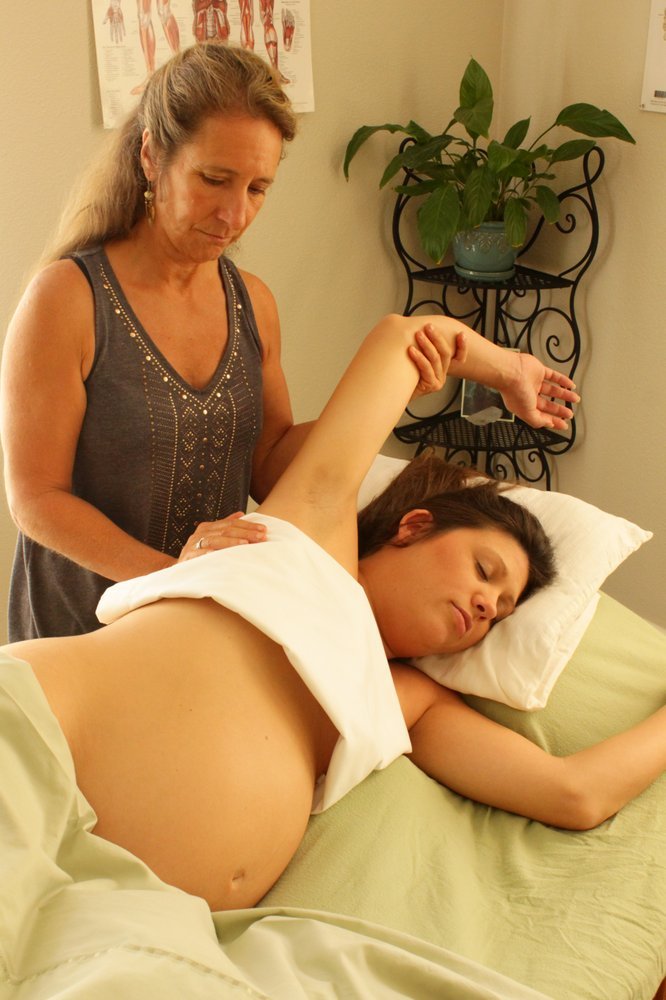 Explore the benefits of and basic concerns about touch during the peri-natal cycle. Multicultural attitudes toward pregnancy are discussed and powerpoint with audio explore the importance of reducing prenatal stress that affect baby’s brain development. This 1 CE course will give you an experience of a MotherTouch online course!
Explore the benefits of and basic concerns about touch during the peri-natal cycle. Multicultural attitudes toward pregnancy are discussed and powerpoint with audio explore the importance of reducing prenatal stress that affect baby’s brain development. This 1 CE course will give you an experience of a MotherTouch online course!
Other courses include more video, powerpoint, articles, and updated information not found in Leslie’s textbook Nurturing Massage for Pregnancy, or her dvd Mastering Pregnancy Massage.
Course Menu
START COURSE HERE: INSTRUCTIONS & NCBTMB CE CREDIT–Click to open & read
Follow these steps to complete this Online course, earn NCBTMB credits, and receive your Certificate of Completion. For information about acceptance of NCBTMB continuing education credit in your state, please consult your professional licensing board. The number of CE’s per course is based partly on NCBTMB reading time measurement of 250 words per minute and partly on actual read time by sample participants.
- READ the learning objectives below.
- STUDY all written content online or printed out.
- WATCH all videos and powerpoint videos.
- LESSONS: Do each Lesson in sequential order–they often build information on one another.
- As you work with a Lesson, the arrow next to the lesson number in the Course Menu will turn Green to help you remember what you have done so far!
- QUIZ: Choose the best answer based on the LESSON material. Refer to the source listed within the question if you need to review. Do Not use random information gathered from internet!
- PROGRESS BAR: The bar above the lessons will fill in with color as you continue through the course.
- Complete the Evaluation Form to provide honest feedback for future programming.
- CERTIFICATE: Upon successful completion of steps 1-5, you may view or print your certificate. You may not alter the certificate. If you find any error, contact MotherTouchClasses@gmail.com to request a correction.
- CE’s: You are responsible to keep track of your CE’s. MotherTouch™ is not responsible for lost or unrecorded CE’s once you have downloaded the certificate.
- SAVING YOUR WORK: You may stop at any time during the course or Quiz and come back to it later. Your answers will be saved.
More About the QUIZ: To receive the MotherTouch™ Certificate of Completion participants must complete all activities listed, utilize materials offered, and answer multiple choice questions. Since you can refer to the text, video or other materials in this course while taking the quiz, you must receive a passing score of 80% in order to pass and receive your certificate.
LEARNING OBJECTIVES — Click to open & read
At the end of this course, the student should be able to:
- List 3 unique aspects of working with pregnant, laboring and postpartum women.
- Discuss global use of touch traditions during pregnancy and birth.
- List and explain 11 benefits of touch during the childbearing cycle.
- Describe 2 ways touch during pregnancy affects a woman’s relationship to mothering her baby.
- Explain 2 myths and relevant facts about touch during pregnancy.
